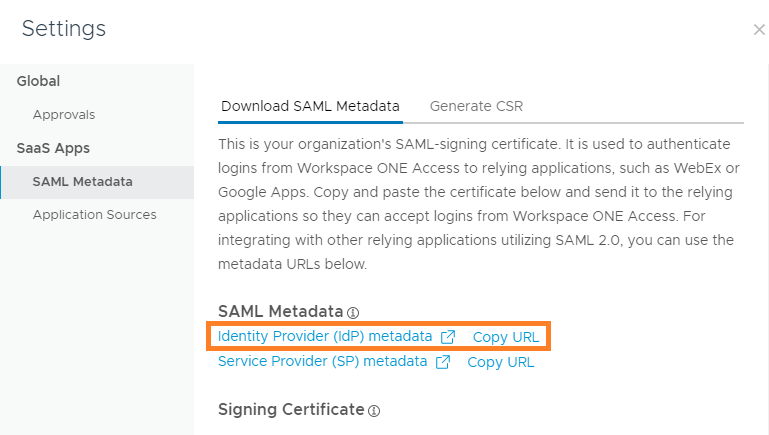After you create a virtual apps collection for the Horizon Cloud integration in the Workspace ONE Access console, configure SAML authentication in the Horizon Cloud tenant.
If you are integrating multiple Horizon Cloud tenants, ensure that you configure SAML authentication in all the tenants.
Important: The
Horizon Cloud tenant appliance and
Workspace ONE Access must be in time sync. If they are not in time sync, when you try to launch
Horizon Cloud desktops and applications, an invalid SAML message appears.
Note: This topic applies to
Workspace ONE Access integration with Horizon Cloud Service on Microsoft Azure with Single-Pod Broker or Horizon Cloud Service on IBM Cloud, using
Workspace ONE Access connector version 22.05 or later.
Procedure
- In the Workspace ONE Access console, select , then click Settings.
- In the left pane, select SAML Metadata.
- In the Download SAML Metadata tab, click Copy URL next to the Identity Provider (IdP) metadata link.
The URL, which is in a format similar to https://
WorkspaceONEAccessFQDN/SAAS/API/1.0/GET/metadata/idp.xml, is copied to your clipboard.
- Log in to the Horizon Cloud tenant.
- Navigate to .
- Click New.
- Configure the required settings.
For Horizon Cloud Service on Microsoft Azure with Single-Pod Broker environments, the following settings appear.
| Option |
Description |
| VMware Workspace ONE Access Metadata URL |
The Workspace ONE Access IdP metadata URL that you copied in step 3. The URL is typically in the following format: https://WorkspaceONEAccessFQDN/SAAS/API/1.0/GET/metadata/idp.xml where WorkspaceONEAccessFQDN is the FQDN of your Workspace ONE Access environment. |
| Timeout SSO Token |
(Optional) The amount of time, in minutes, after which you want the SSO token to time out. |
| Location |
Select a location to filter the Pod drop-down list to the pods associated with that location. |
| Pod |
Select the pod to integrate with Workspace ONE Access. |
| Data Center |
The drop-down displays a numeric related to the Horizon Cloud pod software version. Keep the default. |
| Client Access FQDN |
The FQDN that end users connect to for Horizon Cloud. |
| Workspace ONE Redirection |
If you have set the configuration in Horizon Cloud to force end-user access to go through Workspace ONE Access, you can set this toggle to YES to have the end users' clients automatically redirect to the Workspace ONE Access environment. For information about forcing end-user access through Workspace ONE Access, see Configure the Option to Force End-User Access to Use Workspace ONE Access in the Horizon Cloud documentation. With the automatic redirection set to YES, and forced authentication through Workspace ONE Access configured, when the client attempts to connect to Horizon Cloud the client is automatically redirected to the Workspace ONE Access environment that is integrated with the pod. When the automatic redirection toggle is set to NO, automatic redirection is not enabled. When automatic redirection is not enabled and forced access is configured, the clients display an informational message to the user instead. For more details, see Enforce Having End Users Go Through Workspace ONE Access to Access Their Entitled Desktops and Applications in the Horizon Cloud documentation. |
For Horizon Cloud Service on IBM Cloud environments, the following settings appear.
| Option |
Description |
| VMware Workspace ONE Access Metadata URL |
The Workspace ONE Access IdP metadata URL that you copied in step 3. The URL is typically in the following format: https://WorkspaceONEAccessFQDN/SAAS/API/1.0/GET/metadata/idp.xml where WorkspaceONEAccessFQDN is the FQDN of your Workspace ONE Access environment. |
| Timeout SSO Token |
(Optional) The amount of time, in minutes, after which you want the SSO token to time out. |
| Data Center |
The name of your Horizon Cloud data center. Select the name from the drop-down list. |
| Client Access FQDN |
The Horizon Cloud tenant address. Specify the floating IP address or hostname of the Horizon Cloud tenant appliance, or the Unified Access Gateway IP address or hostname. For example, mytenant.example.com. |
| Workspace ONE Redirection |
If you have set the configuration in Horizon Cloud to force end-user access to go through Workspace ONE Access, you can set this toggle to YES to have the end users' clients automatically redirect to the Workspace ONE Access environment. For information about forcing end-user access through Workspace ONE Access, see Configure the Option to Force End-User Access to Use Workspace ONE Access in the Horizon Cloud documentation. With the automatic redirection set to YES, and forced authentication through Workspace ONE Access configured, when the client attempts to connect to Horizon Cloud the client is automatically redirected to the Workspace ONE Access environment that is integrated with the pod. When the automatic redirection toggle is set to NO, automatic redirection is not enabled. When automatic redirection is not enabled and forced access is configured, the clients display an informational message to the user instead. For more details, see Enforce Having End Users Go Through Workspace ONE Access to Access Their Entitled Desktops and Applications in the Horizon Cloud documentation. |
- Click Save.
A status of green indicates that the integration is successful.
What to do next
Sync the virtual apps collection to sync resources and entitlements from Horizon Cloud to Workspace ONE Access. In the page, select the collection and click or .
After you sync the Horizon Cloud virtual apps collection, you can view desktop and application pools in the Workspace ONE Access console and end users can launch the resources to which they are entitled from the Intelligent Hub app or portal.
Important: Each time resources or entitlements change in Horizon Cloud, a sync is required to propagate the changes to
Workspace ONE Access.
